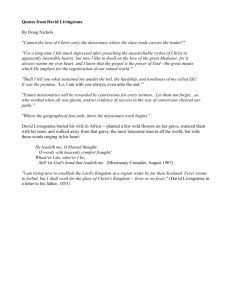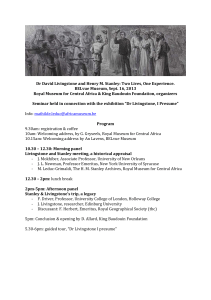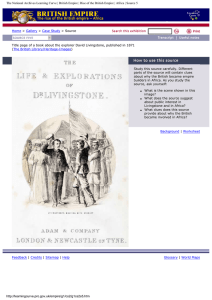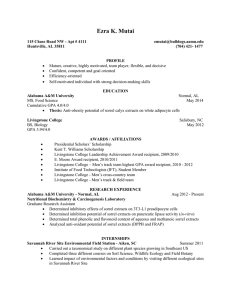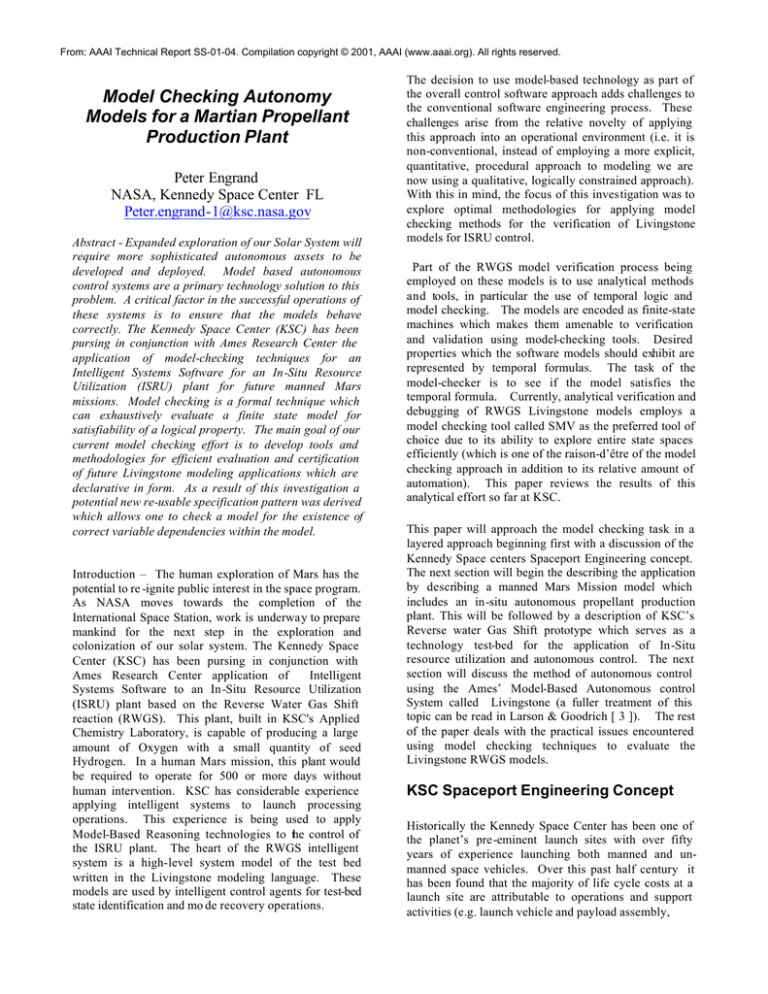
From: AAAI Technical Report SS-01-04. Compilation copyright © 2001, AAAI (www.aaai.org). All rights reserved.
Model Checking Autonomy
Models for a Martian Propellant
Production Plant
Peter Engrand
NASA, Kennedy Space Center FL
Peter.engrand-1@ksc.nasa.gov
Abstract - Expanded exploration of our Solar System will
require more sophisticated autonomous assets to be
developed and deployed. Model based autonomous
control systems are a primary technology solution to this
problem. A critical factor in the successful operations of
these systems is to ensure that the models behave
correctly. The Kennedy Space Center (KSC) has been
pursing in conjunction with Ames Research Center the
application of model-checking techniques for an
Intelligent Systems Software for an In-Situ Resource
Utilization (ISRU) plant for future manned Mars
missions. Model checking is a formal technique which
can exhaustively evaluate a finite state model for
satisfiability of a logical property. The main goal of our
current model checking effort is to develop tools and
methodologies for efficient evaluation and certification
of future Livingstone modeling applications which are
declarative in form. As a result of this investigation a
potential new re-usable specification pattern was derived
which allows one to check a model for the existence of
correct variable dependencies within the model.
Introduction – The human exploration of Mars has the
potential to re -ignite public interest in the space program.
As NASA moves towards the completion of the
International Space Station, work is underway to prepare
mankind for the next step in the exploration and
colonization of our solar system. The Kennedy Space
Center (KSC) has been pursing in conjunction with
Ames Research Center application of
Intelligent
Systems Software to an In-Situ Resource Utilization
(ISRU) plant based on the Reverse Water Gas Shift
reaction (RWGS). This plant, built in KSC's Applied
Chemistry Laboratory, is capable of producing a large
amount of Oxygen with a small quantity of seed
Hydrogen. In a human Mars mission, this plant would
be required to operate for 500 or more days without
human intervention. KSC has considerable experience
applying intelligent systems to launch processing
operations. This experience is being used to apply
Model-Based Reasoning technologies to the control of
the ISRU plant. The heart of the RWGS intelligent
system is a high-level system model of the test bed
written in the Livingstone modeling language. These
models are used by intelligent control agents for test-bed
state identification and mo de recovery operations.
The decision to use model-based technology as part of
the overall control software approach adds challenges to
the conventional software engineering process. These
challenges arise from the relative novelty of applying
this approach into an operational environment (i.e. it is
non-conventional, instead of employing a more explicit,
quantitative, procedural approach to modeling we are
now using a qualitative, logically constrained approach).
With this in mind, the focus of this investigation was to
explore optimal methodologies for applying model
checking methods for the verification of Livingstone
models for ISRU control.
Part of the RWGS model verification process being
employed on these models is to use analytical methods
and tools, in particular the use of temporal logic and
model checking. The models are encoded as finite-state
machines which makes them amenable to verification
and validation using model-checking tools. Desired
properties which the software models should exhibit are
represented by temporal formulas. The task of the
model-checker is to see if the model satisfies the
temporal formula. Currently, analytical verification and
debugging of RWGS Livingstone models employs a
model checking tool called SMV as the preferred tool of
choice due to its ability to explore entire state spaces
efficiently (which is one of the raison-d’être of the model
checking approach in addition to its relative amount of
automation). This paper reviews the results of this
analytical effort so far at KSC.
This paper will approach the model checking task in a
layered approach beginning first with a discussion of the
Kennedy Space centers Spaceport Engineering concept.
The next section will begin the describing the application
by describing a manned Mars Mission model which
includes an in-situ autonomous propellant production
plant. This will be followed by a description of KSC’s
Reverse water Gas Shift prototype which serves as a
technology test-bed for the application of In-Situ
resource utilization and autonomous control. The next
section will discuss the method of autonomous control
using the Ames’ Model-Based Autonomous control
System called Livingstone (a fuller treatment of this
topic can be read in Larson & Goodrich [ 3 ]). The rest
of the paper deals with the practical issues encountered
using model checking techniques to evaluate the
Livingstone RWGS models.
KSC Spaceport Engineering Concept
Historically the Kennedy Space Center has been one of
the planet’s pre-eminent launch sites with over fifty
years of experience launching both manned and unmanned space vehicles. Over this past half century it
has been found that the majority of life cycle costs at a
launch site are attributable to operations and support
activities (e.g. launch vehicle and payload assembly,
Opportunity 1 (2011): 3 flights
Ascent Vehicle,
Prop Production,
Surface
Exploration Gear
Return Habitat,
chemical TEI
Stage (to Mars
orbit)
ERV-1
CargoHab-1 1
Crew
Hab/Lab
Cargo delivered to LEO on Large
Launch Vehicle, rendezvous with
NTR
Opportunity 2 (2013): 1 flight
Crew of 6 Aerocaptures and Lands in
Outbound Hab. Surface rendezvous with
pre -deployed assets
Crew ascends to
Return Hab in
capsule
Outbound Hab delivered to LEO on Large Launch
Vehicle, Crew of 6 delivered to LEO in Shuttle. Both
rendezvous with NTR.
Return
Crew Direct Enters
in capsule, Apollostyle
MAV/EEV
Hab-2
Crew returns to
Earth in Return
Hab (ERV-1)
Figure 1. Manned Mars Mission Model
integration, test &Checkout, fueling etc.). Due to the
complex and sometimes hazardous nature of launching a
mass into space, a large complement of skilled technical
personnel are required for a safe and successful launch.
A key goal of the agency is to provide more efficient
exploitation of space by reducing the costs of accessing
space. Given the current labor intensive approach to
launch site operations, greater degrees of automation
must be employed to increase operational efficiencies.
To that end KSC is focusing on developing automated
launch site technologies which not only help to reduce
cost and enhance safety but also to develop technology
that will be applicable across programs and environments
(including extra-terrestrial launch sites ). Dr. Zubrin, in
his book The Case for Mars [ 1 ], calls for the use of
indigenous resources to lower the mass that must be
carried to Low Earth Orbit. This concept, called In-Situ
Resource Utilization (ISRU), has been captured in
NASA’s new design reference mission which envisions
an initial deployment of a robotic fuel production facility
and depot two years prior to a manned landing. Figure 1
shows a graphic summary of this mission concept. There
are considerable advantages to using indigenous
resources. One of the most significant drivers for the
size of a Mars exploration launch vehicle is the amount
of mass you need to carry to Mars and back. Calculations
show that for every pound carried to Mars and back,
forty (40) pounds must initially be carried to low earth
orbit. The most significant mass fraction of any launch
vehicle is the fuel it carries. Major savings can be
achieved by making the fuel for the ascent from the
Martian surface while on Mars. This reduces the size of
the Mars Lander’s engines and the fuel mass carried.
This savings ripples back through the entire mission
architecture, reducing the size of the launch vehicle,
transfer stage, etc..
The Reverse Water Gas Shift (RWGS) is one potential
solution for the production of propellants on Mars. The
reaction works as follows: Martian atmospheric carbon
dioxide is combined with hydrogen (brought from earth)
in the following reaction.
CO2 + H2 = CO + H2 O
DH = +9 kcal/mole
The water vapor produced, is condensed and collected in
various water trap tanks and is electrolyzed, the oxygen
is stored and the hydrogen is recovered and re-circulated
into the input stream. Since all the hydrogen is reused,
Autonomous Control of a RWGS System
The RWGS test bed is designed for unattended ISRU,
and its control system illustrates many features and
benefits of intelligent software.
RWGS control strategy To achieve maximum oxygen
production, the RWGS system must operate at its full
design capacity as determined by such factors as the
reactor size and membrane surface area. The system
must control the feed flow relationship between
hydrogen and carbon dioxide carefully so as not to waste
reactant or slow production. If component degradation
occurs, the autonomous system must redirect flows to
adapt to changing circumstances. Understanding of this
strategy is of fundamental importance in deriving
specifications for the model checking task
VALVE & FLOW
CO2
H2
CONTROLLERS
VENT
MEMBRANE
COMPRESSOR
R5
R6
RWGS
example of a Livingstone model a valve module
containing mass flow controllers (FC1 and FC2) and
solenoid valves (SV1, SV2 and SV3) regulates the gas
flow as shown in figure 3. The Livingstone model is
hierarchical. A flow branch consists of a two-way
solenoid valve and a mass flow controller. Two flow
branches are connected to a three-way solenoid to make
a flow module. The behavior of the solenoid valves, and
flow controllers are modeled as components. The
engineer defines states for the valve components
corresponding to various normal and abnormal operating
modes (as in shown in figure 4). The labels on the links
correspond to device commands. Logical propositions
define the behavior of the valve while it is in the
associated mode. One of the key benefits of this
modeling paradigm is that the engineer is only
responsible for describing the local behavior of each
component, the relationships that exist between
components and any “system concepts” such as mass
and/or energy balances that affect operation.
Livingstone then uses this specification to compose a
larger, system model that can be used to reason about the
global behavior of the entire system given the mode of
each component. Once the model is complete and
connected to test bed instrumentation, the advisory and
autonomy features of the Livingstone engine are
available for use. These uses include system health
monitoring, diagnosis of component failures, flexible
reconfiguration, redundancy management, adaptability to
degraded environments, and tolerance for component
faults and incomplete sensor information.
HEAT SINK
CONDENSER
WATER TRAP
A7
R14
VENT
OXYGEN
R15
ELECTROLYZER
LL5
“valve module” schematic
WATER TRAP
Figure 2. RWGS Schematic
RWGS and Livingstone
The RWGS test bed uses Livingstone monitoring and
diagnosis software developed at Ames Research Center.
Ames has been working with KSC to apply Livingstone
to ISRU since 1998. The software provides built-in
autonomy capabilities for RWGS. The heart of the
RWGS intelligent system is a high-level system model of
the test bed written in the Livingstone modeling
language. The model is a simple, declarative statement
of the behavior of RWGS components and the
connections between them. Information from the design
of the test bed is simply translated, part-by-part and
concept-by-concept into Livingstone statements. As an
Livingstone model
((defmodule flowModule (?name)
(:structure
(solenoidValve3Way (sv3Way ?name))
(flowBranch (branch1 ?name))
(flowBranch (branch2 ?name))))
(defmodule flowBranch (?name)
(:structure
(flow-control-valve (fc ?name))
(flow-sensor (flowSensor ?name))
(solenoidValve2Way (sv2Way ?name))))
Figure 3. Translating a schematic into Livingstone
Model-Checking the Prototype RWGS
Models
Due to the extended duration of autonomous operations
correct system control depends critically on the
correctness of the Livingstone models. Conventional
approaches to verification of models which rely on
informal testing techniques ,though straight forward to
implement, suffer from a lack of completeness when
attempting to answer questions dealing with global
model behaviors. Livingstone models are declarative in
nature meaning that instead of enumerating all behaviors
the developers simply state constraints on system
behavior leaving specific behaviors implicit.
Nominal modes
close
open
F-in = F-out
P-in = P-out
open
closed
F-out = 0
P-out = nom
cycle-valve
cycle-valve
stuck-open
stuck-closed
F-in = F-out
P-in = P-out
F-out = 0
P-out = nom
Failure modes
Figure 4. Valve Model
Although a Livingstone controller is inherently more
complex than most conventional control software
applications, the fact that it’s models are represented as a
finite state machines make it conducive for modelchecking techniques. A caveat must be stated, though, in
that although model-checking does allows for an
exhaustive search of all states in a model, the obvious
drawback is the size of the state-space being checked
(otherwise known as the “State Explosion Problem”).
One of the fundamental issues for effective verification
of models deals with the construction of meaningful
specifications that verify correct behavior of the model
(where a rough and ready definition of “meaningful” is a
temporal form which captures some global system
behavior, for example high level design specification or
requirements). The specifications should be structured in
order to detect three types of modeling errors. These
errors include, 1) errors in which results are rejected
although in fact they are sufficiently credible (this is
referred to as “Model Builder’s Risk”), 2) errors in
which invalid results are accepted, even though they are
not sufficiently credible (Model Users Risk), and 3)
Errors in which an invalid problem is incorrectly
formulated and the wrong problem is solved generating
an irrelevant modeling result. In order to detect these
faults, the verifier must have an adequate understanding
of RWGS behavior in order to generate effective
verification specifications.
As stated previously, the focus of this investigation is to
explore optimal methodologies for applying model
checking methods for verifying Livingstone models .
For our purposes verification can be defined as: The
process of determining that the Livingstone RWGS
model implementation accurately represents the
developer’s conceptual description and specification.
Before verification is performed the set of verification
specifications need to be stated for which the
Livingstone RWGS model must satisfy.
These
specifications are given a logical formalism which assert
how the system evolves over time. Temporal logic is
commonly used for this purpose where the meaning of a
formula is determined with respect to a transition graph.
Computational Tree Logic (CTL) is the particular type of
temporal logic used for specification representation
which models time as having a branching structure. The
specific model checking tool used is SMV developed at
Carnegie Mellon University (CMU). SMV is based on a
language for describing hierarchical finite–state
concurrent systems. In order to perform verification on
the Livingstone RWGS models the specification as well
as the Livingstone model must first be translated into an
SMV program. This task is performed automatically by
a translator developed by both CMU and the Ames
Software Engineering Group (see Pecheur & Simmons [
5 ]).
Once the translation of both model and
specification have occurred SMV then proceeds to check
that the model satisfies the specification. If the result is
negative SMV will provide the user with a trace which
can be used as a counter-example for the checked
property to aid the developer in tracking down the source
of the error.
Statement of Formal Verification Problem :
The verification problem for Livingstone models can be
schematized as shown in fig. 5 . In words what the
schematic states is the following :
Given :
1. A Livingstone model which is an abstraction of
some physical system.
2. A mathematical model of that physical system ;
Find a corresponding abstraction that maps from the
physical property to the CTL property such that, the
Livingstone model satisfies the CTL property iff the
physical property satisfies the physical system.
Modeller's
conceptual
model
Physical
System
Modelling
Requirements
Livingstone
Model
Abstraction
Evaluator's
conceptual
model
Satisfies
flow is stopped and the absorbed CO2 is extracted from
the catalytic bed through a heating process and pumped
through a set of flow branches to the rest of the system
where Liquid Methane (fuel) and oxygen (oxidizer) are
produced and stored.
Satisfies
INTAKE FANS
Livingstone
V&V
Requirements
Physical
Properties
INTAKE VALVES
MARS AMBIENT
ATMOSPHERE
Abstraction
Figure 5.
SORPTION PUMP
HTR A
HTR B
Another way of stating this is the following :
RADIATOR
1.
2.
3.
4.
5.
6.
Given a physical system governed by physical laws,
A Livingstone model is abstracted from physical
system
The person performing the verification expresses
properties of the physical system (e.g. ODEs, PDEs,
Discrete transitions etc.)
Abstract CTL properties from the physical
representations (properties) such that …
the model satisfies the CTL properties (i.e.
Livingstone verification requirements) …..
If and only if, the Physical system satisfies the stated
Physical properties.
This formal evaluation effort focused on observing and
studying various modeling faults. These faults were then
studied to understand the underlying causes of the faults
phenomena so that specification properties could be
inferred that could lead to future re-usable specification
patterns.
These observations consisted of two modeling faults
(which were instances of the previously explained type 2
fault). These two faults, which had been previously
encountered by the modelers, had their causes already
known prior to the beginning of the formal investigation.
Working with known faults and their causes, allowed us
insight into understanding and development of
appropriate model-checking techniques applicable for
these kinds of faults.
The first fault to be investigated dealt with a
mis -modeled fluid flow behavior which existed in an
earlier version of an ISRU system. This system called
the Sabatier-Electrolysis works as follows: carbon
dioxide from the Martian atmosphere is reacted with
hydrogen (brought from earth).
Carbon dioxide is
obtained by flowing Martian atmosphere through a
component called a sorption pump which contained a
catalytic bed that absorbs the CO2 content of the
atmosphere. Once the bed is saturated atmospheric in-
SORP PUMP-TO-ATM
VENT VALVES
SORP PUMP-TO-SAB./
ZIRC.CELL VALVES
Figure 6. Schematic showing Sorption pump and
neighboring components for a Sabatier-Electrolysis
ISRU
The modeling fault was manifested in the way the flow
branch outlet of the Sorption pump was modeled. In this
case, the developers failed to take into account a fluid
flow property called admittance of this flow-branch into
the overall computation of admittance in the model
(admittance is a measure of fluid impedance of pipes and
orifices). This omission led to the model manifesting
flow through a flow-branch when there should have been
none (i.e. in the situation where a valve upstream of a
pipe, which controlled flow through the flow branch, was
in a closed state the model showed flow being
transmitted through the branch). In order to detect this
fault using CTL, a simple property was specified which
stated the correct behavior of flow through the flow
branch when the control valve was closed . I.e.
It should always be the case that if the admittance outlet
of the pump is off (i.e. no flow is exiting from the
Sorption Pump) then there will be no flow through the
component “z-flow-module”.
Where “z-flow-module” is the component name of the
specific flow branch (Sorp pump -to-Sab/zirc Cell Valves
in fig. 6). Or in CTL form as,
(AG (admittance outlet = off ⇒ flow z -flow-module = off))
( high-out ( relative-flow-magnitude rwgs_trap ))
( high-in ( relative-flow-magnitude O2 ))
RWGS : reactor
rwgs_trap : tank
RWGS trap was also (incorrectly) filling. In reviewing
the models the developers discovered a discrepancy in
the way this flow behavior was constrained. In practice
what was modeled was the following,
O2 : tank
;Facts
SV : Valve
P
(And
(When (on (flow-out rwgs_trap))
(high-out (relative flow-magnitude rwgs_trap)))
P
( on ( flow-out RWGS ))
Electro : electrolyzer
( on ( flow-in rwgs_trap ))
( on ( flow-in SV ))
(When (on (flow-in O2))
(high-in (relative-flow-magnitude rwgs_trap)))
( on ( flow-out rwgs_trap )) ( on ( flow-out SV ))
( on ( flow-in O2 ))
Figure 7. RWGS Schematic for 2nd fault
When the Livingstone mo del and specification were
translated and processed by SMV, a counter-example is
returned. The counter example demonstrated the sought
for admittance problem by showing a violation of the
specification (i.e. outlet admittance = off and z_flowmodule = high.
The second, and more interesting, fault is described as
follows.
The model in which this fault occurred is
schematized in figure 7. Figure 7 shows a schematic of
a preliminary RWGS Livingstone model, showing the
RWGS reactor connected to a condenser tank (RWGS
trap) , control valve (SV), another condenser tank (O2)
and into the electrolyzer. In this situation the developers
wished to model flow between the condenser tanks via a
simple set of constraints. A constraint was needed that
described the condition in which the contents of the
RWGS trap emptied into the O2 trap based only on the
magnitude of their respective relative flow magnitudes.
In Livingstone, one way of representing this behavior
was as an invariant (called a fact in Livingstone) such as,
;Fact
As can be seen by comparing with the first fact the error
lies in the proposition sub-expression,” (high-in (relativeflow-magnitude rwgs_trap)) . Here the argument rwgs_trap
is mistakenly in the place of where the O2 trap argument
name should be.
Though an obvious error that one would expect to detect
easily, this “mis -naming” fault proved to be difficult to
detect both using testing by the developer and model
checking with SMV. This was due to the fact that by this
single object name change a new (and undesired)
constraint was added, i.e.
(When (on (flow-in O2))
(high-in (relative-flowmagnitude rwgs_trap)))
and the desired constraint was non-existent, i.e.
(When (on (flow-in O2))
(high-in (relative-flowmagnitude O2)).
In order to detect this error in CTL the concept of
variable dependency was used. Variable dependency is a
way of checking relations introduced in order to
approximate the continuous physical constraints that are
manifest in the RWGS. When we use the term variable
dependency what we aim in defining is a functional
dependency between Livingstone model variables (i.e. a
variable Y functionally depends on variable X if for a
given X there can be only one Y).
(And
(When (on (flow-out rwgs_trap))
(high-out (relative flow-magnitude
rwgs_trap)))
(When (on (flow-in O2))
(high-in (relative-flow-magnitude O2)))
Where this fact states that if there is an out-flow of fluid
from the RWGS trap then the RWGS trap is in an
emptying state (high-out) and if their should be flow into
the O2 tank then it should be in filling state (high-in). In
fact what was found by the developers during their
normal testing was that when the O2_trap was filling the
This dependency can only exist if it has first been
established that Y causally depends on X in the physical
domain. A Livingstone
model does not causal
dependencies explicitly; everything is expressed as
logical constraints, and one can only look for functional
dependency where causal dependency is already known
to exist. Therefore if one wants to check that a value of
some attribute y is indeed a function of attribute x then
one can state this in CTL as,
(EF ( some x & some y )) ⇒ ( AG (some x ⇒ some y ))
In other words, if for some value of x you get some value
of y, then for the same x you will always get the same
value.
then transitioning to a filling state even though there was
no flow into or out of the trap
Flow-out rwgs-trap = off
Flow-in rwgs-trap = off
Relative-flow-magnitude = equal
The specific dependency we wish to check for is the
nature of the relative flow of the RWGS trap. I.e.
Specification :
∀ some-flow-in, some-flow-out, some-relative-flow,
relative-flow
EF (flow-in rwgs-trap = some-flow-in & flow-out rwgstrap = some-flow-out & relative-flow rwgs-trap = somerelative-flow rwgs-trap) ⇒
Flow-out rwgs-trap = off
Flow-in rwgs-trap = off
Relative-flow-magnitude = high-in
AG (flow-in rwgs-trap = some -flow-in & flow-out rwgstrap = some-flow-out ⇒ relative-flow rwgs-trap= somerelative-flow rwgs-trap)
As can be seen this specification is a disjunction of two
separate propositions which would require SMV to
produce two separate traces, one for each proposition in
order to provide a complete counter-example for this
property, i.e.
Figure 9.
2nd counter –example
Inspection of the error trace then demonstrated a problem
with the relative-flow magnitude of the RWGS trap
showing a violation of the specification, hence flagging a
problem with the RWGS trap’s relative flow magnitude
constraint.
Results & Observations
EF p => AG q = AG ~p ∪ AG q.
By design SMV only will give a single counter-example
trace, that for the EF p case. In practice using SMV,
applying this specification needs to proceed in a two
step manner. First, the entire specification, as stated
above, was applied, returning a one-state trace showing
an example of EF p.
Flow-out rwgs-trap = off
Flow-in rwgs-trap = off
Relative-flow-magnitude = equal
Figure 8. First Counter –Example
EF (some x & some y) is true
The second step involved getting a counter-example of
AG ~p and for the property as a whole. In order to do
this the second half of the specification was reinstantiated as a separate specification using the flow and
relative-flow values from the first counter-example.
Application of this new specification generated the
second counter-example trace showing a two state trace
beginning with the RWGS trap in a quiescent state and
The first three observations deal with the computational
efficiency of the model checker.
•
The size of the RWGS Model used which contained
these two faults scenarios is @ 1017 States.
Although this is a relatively large state space SMV
needed less than a minute to return a result. This
was due to the structure of the Livingstone model
itself which was relatively “flat” (i.e. the maximum
depth of transitions were no more than three deep).
•
The size of the Latest RWGS Model is estimated @
10 55 states
•
An enhancement to SMV by Bwolen Yang [ 4 ],
greatly enhances the memory performance of SMV
for the larger version of the model.
•
Writing a correct temporal specifications can be a
subtle an error prone task. Part of the task of writing
temporal specifications requires a need to “V&V”
the specification itself in order to check that the
syntax and form of the formula truly conveys the
correct semantics of the property one wants to check
for.
•
As a result of this investigation of variable
dependency of the RWGS trap a new specification
pattern was derived which allows one to check in a
model that the correct variable dependencies exist
(and that valid causality constraints exist among
system components and modules) within the model.
A property specification pattern is a generalized
description of a commonly occurring requirement on
the permissible state/event sequences in a finite-state
model of a system. A property specification pattern
describes the essential structure of some aspect of a
system's behavior and provides expressions of this
behavior in a range of common formalisms ( see
Dwyer, Avrunim, Corbett [ 2 ]). One can think of a
specification pattern as a generic correctness
property for a class of objects, such as the property
of avoidance of dead-locks in concurrent/parallel
systems. In terms of model checking and SMV
these two type 2 errors characterized properties of
the models which were static in nature and did not
involve reasoning about the state transition
properties of the model which is the forte of SMV.
The schematic in figure 10 summarizes the
methodology for implementing this pattern within
SMV.
•
As an added benefit during the investigation using
variable dependency, two additional modeling faults
were detected which went undetected during the
developers normal testing phase of the model.
Perform
Causal
Analysis
Establish
Functional
Dependencies
Obtain 2nd
counterexample
-Review
Counter-example
- Idenitfy variable &
values which contradict
specification
MPL => SMV
Translation
SMV
Fail 1st
Spec
?
Pass/Fail
?
Analyze 2nd
Trace
Done
Figure 10. Variable Dependency Methodology
References
[1]
R. Zubrin and R. Wagner. The Case for Mars:
The plan to settle the Red Planet and why we must. The
Free Press, 1996.
Conclusion
Expanded exploration of our Solar System will require
more sophisticated autonomous assets to be developed
and deployed. The Model based Autonomous system is
a primary technology solution to this problem. A critical
factor in the successful operations of these systems is to
ensure that the models behave correctly, but due to their
complexity conventional informal testing techniques will
need to be augmented by more formal approaches.
Toward this goal this paper presented some preliminary
observations and results in the use of model-checking
techniques in the evaluation of a certain kind of model
(i.e. declarative Livingstone models). As with any kind
of evaluation, the evaluation is only as good as it’s
measure, therefore the generation of formal
specifications is of fundamental importance. The formal
methods practitioner is Challenged to craft a set of
correct and concise temporal specifications which
capture behaviors that can query the model for safety and
liveness properties This task is made easier if many of
these specifications can be captured as specifications
patterns which can be re-used for in evaluation of
different modeling applications.
[2]
Property
Specification
for
Finite-State
Verification, Dwyer M.B., Avrunin G.S., Corbett J.C.,
http://www.cis.ksu.edu/santos/spec-patterns, 1999.
[3]
Intelligent Systems Software for Human Mars
Missions, Larson W.E.,
Goodrich C.H.,
51st
International Astronautical Congress, Rio de Janeiro,
Brazil, 2000.
[4]
Optimizing Symbolic Model Checking for
Invariant-Rich Models (abstract). B.Yang, R. Simmons,
R. Bryant, and D. O'Hallaron. In Proc. of International
Conference on Computer-Aided Verification (CAV'99).
[ 5 ]
Charles Pecheur, Reid Simmons. From
Livingstone to SMV: Formal Verification for
Autonomous Spacecrafts. Proceedings of First Goddard
Workshop on Formal Approaches to Agent-Based
Systems, NASA Goddard, April 5-7, 2000. To appear in
Lecture Notes in Computer Science, Springer Verlag.

